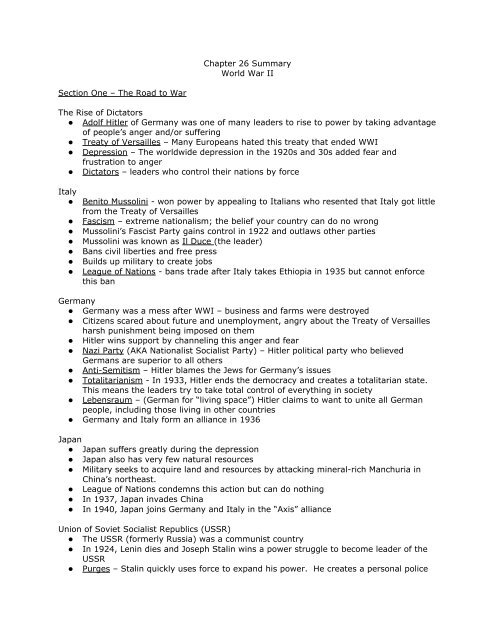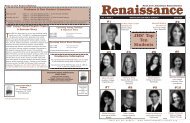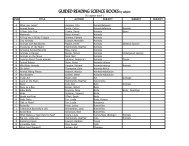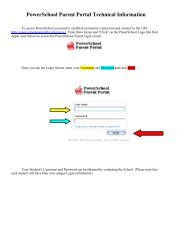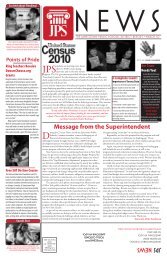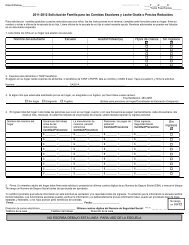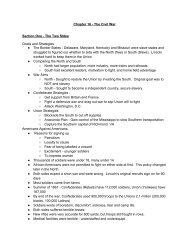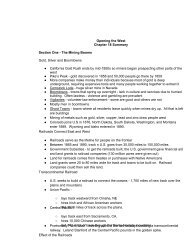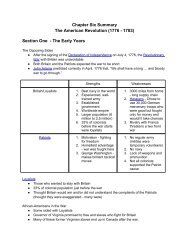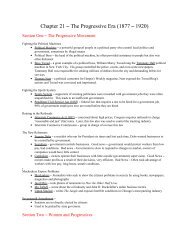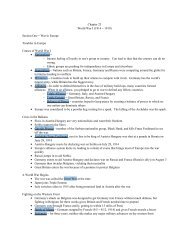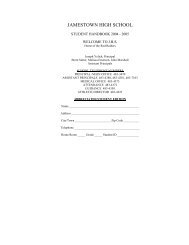Chapter 26 Summary World War II Section One â The Road to War ...
Chapter 26 Summary World War II Section One â The Road to War ...
Chapter 26 Summary World War II Section One â The Road to War ...
Create successful ePaper yourself
Turn your PDF publications into a flip-book with our unique Google optimized e-Paper software.
<strong>Chapter</strong> <strong>26</strong> <strong>Summary</strong><br />
<strong>World</strong> <strong>War</strong> <strong>II</strong><br />
<strong>Section</strong> <strong>One</strong> – <strong>The</strong> <strong>Road</strong> <strong>to</strong> <strong>War</strong><br />
<strong>The</strong> Rise of Dicta<strong>to</strong>rs<br />
● Adolf Hitler of Germany was one of many leaders <strong>to</strong> rise <strong>to</strong> power by taking advantage<br />
of people’s anger and/or suffering<br />
● Treaty of Versailles – Many Europeans hated this treaty that ended WWI<br />
● Depression – <strong>The</strong> worldwide depression in the 1920s and 30s added fear and<br />
frustration <strong>to</strong> anger<br />
● Dicta<strong>to</strong>rs – leaders who control their nations by force<br />
Italy<br />
●<br />
●<br />
●<br />
●<br />
●<br />
●<br />
●<br />
Beni<strong>to</strong> Mussolini - won power by appealing <strong>to</strong> Italians who resented that Italy got little<br />
from the Treaty of Versailles<br />
Fascism – extreme nationalism; the belief your country can do no wrong<br />
Mussolini’s Fascist Party gains control in 1922 and outlaws other parties<br />
Mussolini was known as Il Duce (the leader)<br />
Bans civil liberties and free press<br />
Builds up military <strong>to</strong> create jobs<br />
League of Nations - bans trade after Italy takes Ethiopia in 1935 but cannot enforce<br />
this ban<br />
Germany<br />
● Germany was a mess after WWI – business and farms were destroyed<br />
● Citizens scared about future and unemployment, angry about the Treaty of Versailles<br />
harsh punishment being imposed on them<br />
● Hitler wins support by channeling this anger and fear<br />
● Nazi Party (AKA Nationalist Socialist Party) – Hitler political party who believed<br />
Germans are superior <strong>to</strong> all others<br />
● Anti-Semitism – Hitler blames the Jews for Germany’s issues<br />
● Totalitarianism - In 1933, Hitler ends the democracy and creates a <strong>to</strong>talitarian state.<br />
This means the leaders try <strong>to</strong> take <strong>to</strong>tal control of everything in society<br />
● Lebensraum – (German for “living space”) Hitler claims <strong>to</strong> want <strong>to</strong> unite all German<br />
people, including those living in other countries<br />
● Germany and Italy form an alliance in 1936<br />
Japan<br />
● Japan suffers greatly during the depression<br />
● Japan also has very few natural resources<br />
● Military seeks <strong>to</strong> acquire land and resources by attacking mineral-rich Manchuria in<br />
China’s northeast.<br />
● League of Nations condemns this action but can do nothing<br />
● In 1937, Japan invades China<br />
● In 1940, Japan joins Germany and Italy in the “Axis” alliance<br />
Union of Soviet Socialist Republics (USSR)<br />
● <strong>The</strong> USSR (formerly Russia) was a communist country<br />
● In 1924, Lenin dies and Joseph Stalin wins a power struggle <strong>to</strong> become leader of the<br />
USSR<br />
● Purges – Stalin quickly uses force <strong>to</strong> expand his power. He creates a personal police
force that execute his rivals and sends millions of people suspected of disloyalty <strong>to</strong><br />
forced labor camps in Siberia, the Russian tundra<br />
American Neutrality<br />
· Americans were stuck in the Great Depression in the 1930s and had no desire<br />
<strong>to</strong> be involved in foreign troubles<br />
· Neutrality Acts - passed in 1935 and 1937, they banned weapons sales and<br />
loans with countries who were at war.<br />
· Congress knew many countries had yet <strong>to</strong> pay US for debts from WWI and<br />
Congress wanted <strong>to</strong> prevent even more debt<br />
Germany on the March<br />
● Lebensraum – Hitler begins <strong>to</strong> claim land <strong>to</strong> expand<br />
● Rhineland (March, 1936) – German claims this land west of the Rhine River between it<br />
and France. According <strong>to</strong> the Treaty of Versailles, this area was <strong>to</strong> be neutral.<br />
● Austria (March, 1938) – Hitler claimed German speaking Austria should be part of<br />
Germany, so he sent troops <strong>to</strong> take it over.<br />
● Sudetenland (September, 1938)– <strong>The</strong> area of Czechoslovakia was home <strong>to</strong> German<br />
speakers. Hitler falsely claimed they were being mistreated. <strong>The</strong> Czechs were willing<br />
<strong>to</strong> fight Germany, but Britain and France, looking <strong>to</strong> avoid a war, chose <strong>to</strong> meet with<br />
Hitler in Munich <strong>to</strong> discuss it.<br />
● Munich Conference – Britain and France decide <strong>to</strong> give Hitler the Sudetenland as long<br />
as Hitler promise <strong>to</strong> take nothing else. Very popular at the time.<br />
● Appeasement – avoiding war by accepting Germany’s demands. This turns out <strong>to</strong> be<br />
a BAD idea.<br />
● Czechoslovakia (March, 1939) – Hitler takes the rest of the country after promising<br />
not <strong>to</strong>. Britain and France do nothing.<br />
● German is eyeing Poland, but afraid USSR would respond.<br />
● Soviet-German Non-Aggression Pact (August, 1939) –Germany and USSR agree <strong>to</strong><br />
not fight each other<br />
● Germany now free <strong>to</strong> attack Poland<br />
<strong>Section</strong> Two – <strong>War</strong> Begins<br />
<strong>War</strong> in Europe<br />
● FDR with the rest of the country in wanting <strong>to</strong> avoid war<br />
● Germany Invades Poland - 9/1/1939 – two days later Britain and France declare war<br />
on Germany and WW<strong>II</strong> has begun<br />
● Blitzkrieg (Lightning <strong>War</strong>) – Germany has a terrific advantage over Poland in<br />
technology. Battle plan is <strong>to</strong> first bomb with planes, then blast away with tanks, and<br />
finally invade with thousands of troops.<br />
● USSR invades eastern Poland and split the country with Germany<br />
● USSR Baltic countries of Lithuania, Latvia and Es<strong>to</strong>nia.<br />
● Winter of 1939-1940 was quiet on the western front (France and Belgium)<br />
● Maginot Line – fortified defense of France along German border from Belgium <strong>to</strong><br />
Switzerland made of steel and concrete<br />
● April,1940 - Hitler takes Denmark and Norway<br />
● May, 1940 – Germany attacks Netherlands and Belgium, who are both quickly<br />
overwhelmed<br />
● Allied Powers – Great Britain, France, and their allies.<br />
● Allied Troops chased <strong>to</strong> beach at Dunkirk in France. 800 British ships help <strong>to</strong> ferry<br />
300,000 across the English Channel<br />
● Axis Powers – Germany, Italy and Japan
●<br />
June 14, 1940 – Germans march in<strong>to</strong> Paris and France falls one week later<br />
Battle of Britain<br />
● August, 1940 – all that was left <strong>to</strong> fight Hitler in Europe was Britain<br />
● Luftwaffe – the German Air Force who began <strong>to</strong> bomb air bases, shipyards, and<br />
industries in August, 1940 in the Battle of Britain.<br />
● Battle of Britain –largely an air war over Britain in which the Germans hoped <strong>to</strong> crush<br />
the will of British <strong>to</strong> fight<br />
● Wins<strong>to</strong>n Churchill – British Prime Minister provides inspiration <strong>to</strong> English <strong>to</strong> continue <strong>to</strong><br />
fight<br />
● Blackouts – Londoners and others living in cities hid their urban neighborhoods by<br />
covering windows <strong>to</strong> s<strong>to</strong>p light from escaping. German planes had difficulty finding<br />
targets.<br />
● RAF – British Royal Air Force uses small fighter planes and a new invention, radar, <strong>to</strong><br />
ward of the Luftwaffe<br />
● Vic<strong>to</strong>ry for British is one of courage and will<br />
Germany Turns East –<br />
● Germany needs natural resources of the Soviet Union and seeks land (lebensraum)<br />
● June, 1941 – Germany attacks USSR and violates its own treaty.<br />
● Scorched Earth – Germany sought <strong>to</strong> destroy everything in its wake so that USSR<br />
would not be able <strong>to</strong> use anything and <strong>to</strong> terrorize the Soviet people<br />
● Soviets destroyed own lands, crops, dams, fac<strong>to</strong>ries before Hitler’s men could get <strong>to</strong><br />
them and use them.<br />
● Took 500,000 Soviet soldiers captive<br />
America and the <strong>War</strong><br />
● Most U.S. citizens support Allies but do not want <strong>to</strong> go <strong>to</strong> war<br />
● FDR also wanted <strong>to</strong> stay out of the war, but made preparations in case entering was<br />
necessary<br />
● Neutrality Act (1939) – Also called “Cash and Carry” - Any warring nations can by<br />
US goods as long as they come and get them and pay cash (US still fighting the<br />
Depression)<br />
● Selective Training and Service Act (1940) – First peacetime draft in US his<strong>to</strong>ry, it calls<br />
on men 21 <strong>to</strong> 35<br />
1940 Election<br />
● FDR decides <strong>to</strong> run for a third term because of the Depression and mounting war<br />
concerns.<br />
● Breaks the two-term precedent set by George Washing<strong>to</strong>n<br />
● Easy vic<strong>to</strong>ry by FDR over Republican Wendell L. Willkie<br />
U.S. Involvement Grows<br />
● FDR now supports Allies openly<br />
● Lend-Lease Act (1941) – allows U.S. <strong>to</strong> sell, lend or lease weapons <strong>to</strong> any<br />
country “vital <strong>to</strong> defense of U.S.” – essentially Britain, whom had begged for U.S. help<br />
through Wins<strong>to</strong>n Churchill<br />
Atlantic Charter<br />
● Churchill and FDR meet <strong>to</strong> discuss creation of goals for the “destruction of Nazi<br />
tyranny” but we are not yet at war<br />
● Urged disarmament (giving up weapons) and a permanent system of national security<br />
(this would become the United Nations)
<strong>The</strong> Japanese Threat<br />
● Japan taking over much of the Pacific while Italy and Germany take over Europe<br />
● Japan has very few natural resources and sought areas that would provide them,<br />
especially oil<br />
<strong>The</strong> U.S. Responds<br />
● US responds <strong>to</strong> Japanese aggression by applying economic pressure – we froze all<br />
Japanese funds (money reserves) in US banks and s<strong>to</strong>pped sale of oil, gas, and other<br />
products <strong>to</strong> Japan<br />
● Oc<strong>to</strong>ber, 1941 – General Hideki Tojo takes over from Prime Minister Funimaro<br />
Konoye, who believed Japan could not defeat the US. Tojo disagreed.<br />
● November 20, 1941 – Japan and U.S. begin talks in Washing<strong>to</strong>n.<br />
● While these talks are going on, Japan is planning for war with U.S.<br />
Attack on Pearl Harbor<br />
● 7:55 AM on December 7, 1941 – Japanese warplanes attack the US naval base at<br />
Pearl Harbor in the Terri<strong>to</strong>ry of Hawaii<br />
● <strong>The</strong> U.S. Pacific Fleet had anchored our ships in a neat row, perfect for attack<br />
● 2300 soldiers were killed and many ships, including the USS Arizona, were sunk<br />
● Fortunately, all three aircraft carriers were at sea at the time of the attack or our<br />
whole fleet would have been wiped out.<br />
<strong>Section</strong> Three – On the Home Front<br />
America Prepares<br />
● After Pearl Harbor, US citizens are motivated and prepare <strong>to</strong> fight with amazing speed<br />
Building an Army<br />
● Selective Service Acts (1940, 1941) – first peacetime draft, this laws began building<br />
the military before we declared war<br />
● G.I. – Clothing given <strong>to</strong> soldiers was labeled “government issue.” GI became a<br />
nickname for US soldiers<br />
● Basic training – 8 weeks <strong>to</strong> learn how <strong>to</strong> handle guns, dig trenches, pitch tents, and<br />
get in shape<br />
● 250,000 women join the military<br />
● WACs – Women’s Air Corps<br />
● WAVES – Women Appointed for Voluntary Service in the Navy<br />
Creating a <strong>War</strong> Economy<br />
● Mobilization - US had <strong>to</strong> get ready for war<br />
● <strong>War</strong> Production Board – supervised the conversion of industries <strong>to</strong> war production.<br />
Car companies would make jeeps, ships, and planes for example<br />
● Office of Peace Administration – limited consumer prices and rents <strong>to</strong> prevent inflation<br />
● National <strong>War</strong> Labor Board – cut down on work s<strong>to</strong>ppages and problems like strikes <strong>to</strong><br />
ensure things get made quickly<br />
Financing the <strong>War</strong><br />
● From 1941 <strong>to</strong> the end of the war in 1945, the US spent $320 billion (more than 10<br />
times what we spent in WWI)<br />
●<br />
●<br />
Revenue Act – raised corporate taxes and made most citizens pay an income tax<br />
<strong>War</strong> Bonds – govt. borrowed money from citizens. <strong>The</strong>se were advertised by<br />
celebrities and movie stars
<strong>War</strong>time American Sacrifices – citizens had <strong>to</strong> do without some items and cut down on<br />
others<br />
●<br />
●<br />
●<br />
●<br />
●<br />
Rationing – consumers could only buy a limited amount of certain goods (ex. gasoline,<br />
tires, sugar, meat<br />
Vic<strong>to</strong>ry Gardens – private gardens planted by citizens<br />
Scrap Drives – children collected metals and rubber <strong>to</strong> aid the war effort<br />
Civil Defense – civilian volunteers who kept eye out for air attacks<br />
Office of <strong>War</strong> Information – propaganda office <strong>to</strong> keep citizens supporting the war<br />
effort<br />
Women and Minorities<br />
● Women and minorities again <strong>to</strong>ok industrial jobs as men went <strong>to</strong> war<br />
● “Rosie the Riveter” – a propaganda character who urged women that it was good <strong>to</strong><br />
work in industry – powerful female character created a new image of what it means <strong>to</strong><br />
be a woman<br />
● 1 million Blacks served in the armed forces during the war<br />
● Blacks mostly still in segregated units and lower level jobs<br />
● 1942 – blacks and whites train <strong>to</strong>gether in officers school for first time<br />
● Tuskegee Airmen – one of the most decorated units of WW<strong>II</strong>, this all black group shot<br />
down over 200 planes<br />
● A. Philip Randolph – gets FDR <strong>to</strong> ban discrimination against Blacks in defense industry<br />
● Blacks continue <strong>to</strong> move from the south <strong>to</strong> northern cities <strong>to</strong> get better jobs<br />
● Race riots broke out in cities on occasion as whites feared losing their jobs/<br />
neighborhoods<br />
● Code Talkers – Navajo Indians’ language was used <strong>to</strong> put secret messages in code.<br />
Japanese Internment<br />
● After Pearl Harbor, many Americans distrusted Japanese-Americans, especially on the<br />
west coast<br />
● Nisei – 2/3s of Japanese Americans; they were born in the US<br />
● Executive Order 9066 - FDR issued this order on February 19, 1942. It ordered<br />
100,000 Japanese Americans <strong>to</strong> internment camps for the duration of the war<br />
● Internment Camps – crowded and uncomfortable, these camps served as homes for<br />
thousands of relocated Japanese Americans<br />
● Japanese Americans were given little time <strong>to</strong> prepare, so most had <strong>to</strong> sell of homes<br />
and businesses at great losses<br />
● Korematsu v. United States (1944) – Fred Korematsu sues the US for discrimination<br />
as a result of his internment and loses in Supreme Court.<br />
● 1988 – Under President Clin<strong>to</strong>n, the US formally apologizes for Japanese Internment<br />
and gives each survivor $20,000. Fred Korematsu is on hand for the formal event<br />
<strong>Section</strong> Four –<strong>War</strong> in Europe and Africa<br />
North African Campaign<br />
●<br />
●<br />
●<br />
US and 23 Allies, including Britain and the Soviet Union, decided <strong>to</strong> focus on defeating<br />
Germany before Japan<br />
Goal was <strong>to</strong> create a two front war – Brits and US in western Europe, the USSR in the<br />
east<br />
To get US soldiers experience, it was decided <strong>to</strong> attack German forces in Africa before
●<br />
●<br />
invading Europe<br />
Erwin “Desert Fox” Rommel – German military genius in Africa<br />
Allies chase Germany out of Africa by May, 1943 under leadership of US General<br />
Dwight D. Eisenhower<br />
Invasion of Italy<br />
●<br />
●<br />
●<br />
●<br />
George S. Pat<strong>to</strong>n of the US and Bernard Montgomery of Britain lead the Allies in<strong>to</strong><br />
Sicily in summer of 1943, and on <strong>to</strong> the mainland of Italy<br />
Italian citizens overthrow Mussolini as the Allies are advancing.<br />
June, 1944 – the Allies retake Rome, the capital of Italy<br />
Bombing of Germany – Allies begin <strong>to</strong> bomb German targets day and night and kill<br />
thousands of civilians in cities in order <strong>to</strong> break Germany’s will <strong>to</strong> fight.<br />
<strong>The</strong> Eastern Front<br />
● <strong>The</strong> Soviet Union fought Germany alone on the eastern front<br />
● Siege of Leningrad – <strong>The</strong> Germans blockaded the city of Leningrad for 900 days<br />
causing starvation of thousands of Soviet citizens by early 1944<br />
● Attack on Moscow – Germans pushed all the way <strong>to</strong> the Soviet capital, but were<br />
caught without necessary supplies <strong>to</strong> battle the harsh Soviet winters<br />
● Battle of Stalingrad – Germans were cut off from supply routes deep in<strong>to</strong> the USSR<br />
as winter struck. By Feb, 1943, the Germans had surrendered. This was the turning<br />
point on the eastern front as the Soviet began <strong>to</strong> push the Germans back in<strong>to</strong> Europe<br />
Invasion of France<br />
● Operation Overlord – planned Allied invasion of France <strong>to</strong> create a two front war for<br />
Germany<br />
● D-Day (June 6, 1944) – Allied ships carried thousands of men in<strong>to</strong> an attack on<br />
Normandy beaches, code named “Omaha,” “Utah,” “Gold,” “Juno,” and “Sword.” <strong>The</strong>y<br />
faced withering machine gun fire and landmines during the attack<br />
● 35,000 US troops landed at Omaha, 23,000 landed at Utah. 75,000 British and<br />
Canadian troops landed ashore as well.<br />
● <strong>The</strong> Allies now had opened up a western front, dividing the German army<br />
● August 25, 1944 – French and US troops liberate (free) Paris <strong>to</strong> cheering citizens<br />
Vic<strong>to</strong>ry in Europe<br />
● Germany was facing a two front war and losing in both directions<br />
● Battle of the Bulge – Germans put <strong>to</strong>gether one last ditch attack along a 50 front in<br />
Belgium in the dead of winter, 12/1944<br />
● After weeks of fighting, the US troops push the Germans back at the Battle of the<br />
Bulge and headed in<strong>to</strong> Germany<br />
● February, 1945 – the Soviets had pushed through Poland and just <strong>to</strong> the outskirts of<br />
Berlin<br />
● April 30, 1945 – Hitler realizes the situation is hopeless and commits suicide<br />
● V-E Day (Vic<strong>to</strong>ry in Europe) - May 7, 1945 – Germany signs an unconditional<br />
surrender<br />
● April 12, 1945 – FDR dies at vacation home in <strong>War</strong>m Springs, Georgia and VP Harry S.<br />
Truman becomes the President<br />
<strong>The</strong> Holocaust<br />
● As the Allies began <strong>to</strong> free German occupied areas, they began <strong>to</strong> learn of
●<br />
●<br />
●<br />
Hitler’s “Final Solution” – a plan <strong>to</strong> kill all Jews, along with gypsies, gays, Slavs, Soviet<br />
soldiers and mentally and physically disabled people<br />
Genocide – the deliberate killing of a group of people<br />
About 6 million Jews were killed in addition <strong>to</strong> millions of others in “Concentration<br />
Camps” built for this purpose such as Dachau, Buchenwald and Auschwitz<br />
Allied governments had evidence of death camps as early as 1942, but the Holocaust<br />
was NOT a reason the US entered the war in 1941.<br />
<strong>Section</strong> Five – <strong>War</strong> in the Pacific<br />
<strong>The</strong> Philippines Fall<br />
● After months of fighting, exhausted Allied troops defending the Bataan Peninsula<br />
(west of Manilla), surrendered on April 9, 1942<br />
● Bataan Death March – Japanese troops forced the starving and sick troops <strong>to</strong> march<br />
60 miles <strong>to</strong> a prison camp. About 76,000 troops started out but only 56,000 made it<br />
through the beatings and lack of food and rest.<br />
● General Douglas MacArthur, head of the Filipinos and US troops, vows, “I shall<br />
return.”<br />
Island Hopping<br />
● US troop morale was low in the Pacific at first<br />
● Battle of Midway (June, 1942) – US destroys four Japanese aircraft carriers and<br />
hundreds of planes<br />
● Island Hopping - US strategy in the Pacific where US would attack and capture<br />
certain key islands and leave others alone <strong>to</strong> work closer and close <strong>to</strong> Japan. Created<br />
uncertainty in Japan because they did not know what islands <strong>to</strong> defend<br />
● SeeBees – Construction Battalions – would construct necessary airfields/ports in areas<br />
taken<br />
● Battle of Guadalcanal – (8/1942 <strong>to</strong> 2/1943) – US overcome stiff resistance on an<br />
island filled with Japanese tunnels<br />
● June,1944 – US retakes Guam. US can now reach Japan by bombers.<br />
● March, 1945 – US takes Iwo Jima (famous for the flag raising pho<strong>to</strong>graph)<br />
● June,1945 – US captures Okinawa, an island very close <strong>to</strong> Japan. Japanese battle<br />
fiercely and thousands of Americans are killed and many more are wounded.<br />
● Kamikaze – Japan pilots who are trained <strong>to</strong> crash their planes in<strong>to</strong> American ships in<br />
an effort <strong>to</strong> sink them<br />
<strong>The</strong> End of the <strong>War</strong><br />
● Manhattan Project – IN 1942, FDR orders US operation <strong>to</strong> create an a<strong>to</strong>mic bomb in<br />
secrecy<br />
● July 16, 1945 – the first a<strong>to</strong>mic bomb is set off in the New Mexico desert as a test<br />
after being developed at a secret lab at Los Alamos, NM<br />
● Truman’s Decision – Truman did not know of the bomb until only a few weeks before<br />
his decision <strong>to</strong> drop it<br />
● Truman knew the a<strong>to</strong>mic bomb would kill many innocent civilians, but he also knew<br />
that if it ended the war, he might save many American soldiers’ lives<br />
● Potsdam Declaration – Truman warns Japan <strong>to</strong> surrender or face “prompt and utter<br />
destruction.” When the Japanese did not surrender, Truman authorized the use of the<br />
a<strong>to</strong>mic bomb<br />
● Enola Gay – (August 6, 1945) – this US bomber flew alone over the city of Hiroshima<br />
and dropped “Little Boy,” an a<strong>to</strong>mic bomb that leveled the city and killed between<br />
80,000 and 120,000.<br />
● Fat Man – When Japan did not surrender, “Fat Man” was dropped on the city of<br />
Nagasaki, killing between 35,000 and 75,000 people
● <strong>The</strong> Emperor of Japan then called for surrender.<br />
● V-J Day (Vic<strong>to</strong>ry over Japan) – August 15, 1945<br />
<strong>War</strong> Trials<br />
● Nuremberg Trials – German officials were tried in a civilian court and given the<br />
opportunity <strong>to</strong> defend themselves against charges of war crimes. Shows the world<br />
the Allies are focused on the rule of law, not revenge. Improvement of the Versailles<br />
Treaty.<br />
● Details of the Holocaust were used as evidence.<br />
● Robert H. Jackson – this Supreme Court Justice was selected by FDR before his death<br />
<strong>to</strong> head the US delegation. He was from James<strong>to</strong>wn, NY.<br />
● Tokyo Trials - similar in concept <strong>to</strong> Nuremberg, these trials held Japanese officials<br />
accountable for war crimes.<br />
Cost of the <strong>War</strong><br />
● WW<strong>II</strong> was the most destructive conflict in his<strong>to</strong>ry<br />
● 55 millions deaths<br />
● More than half of the deaths were citizens killed by bombings, starvation, <strong>to</strong>rture,<br />
disease, and murder<br />
● <strong>The</strong> US lost 322,000 men and had 800,000 injured.<br />
● <strong>The</strong> Soviet Union (USSR) saw 22 million of their citizens die


